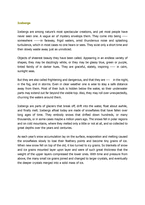영문 Icebergs 영어작문
Icebergs are among nature몶s most spectacular creations, and yet most people have never seen one. A vague air of mystery envelops them. They come into being ----- somewhere ------in faraway, frigid waters, amid thunderous noise and splashing turbulence, which in most cases no one hears or sees. They exist only a short time and then slowly waste away just as unnoticed.
Objects of sheerest beauty they have been called. Appearing in an endless variety of shapes, they may be dazzlingly white, or they may be glassy blue, green or purple, tinted faintly of in darker hues. They are graceful, stately, inspiring ----- in calm, sunlight seas.
But they are also called frightening and dangerous, and that they are ---- in the night, in the fog, and in storms. Even in clear weather one is wise to stay a safe distance away from them. Most of their bulk is hidden below the water, so their underwater parts may extend out far beyond the visible top. Also, they may roll over unexpectedly, churning the waters around them.
Icebergs are parts of glaciers that break off, drift into the water, float about awhile, and finally melt. Icebergs afloat today are made of snowflakes that have fallen over long ages of time. They embody snows that drifted down hundreds, or many thousands, or in some cases maybe a million years ago. The snows fell in polar regions and on cold mountains, where they melted only a little or not at all, and so collected to great depths over the years and centuries.
As each year몶s snow accumulation lay on the surface, evaporation and melting caused the snowflakes slowly to lose their feathery points and become tiny grains of ice. When new snow fell on top of the old, it too turned to icy grains. So blankets of snow and ice grains mounted layer upon layer and were of such great thickness that the weight of the upper layers compressed the lower ones. With time and pressure from above, the many small ice grains joined and changed to larger crystals, and eventually the deeper crystals merged into a solid mass of ice.




 분야
분야


